Popillia japonica (Japanese Beetle) Pest Alert
A coordinated response to eradicate Popillia japonica from Metro Vancouver
March 2024
Popillia japonica was found for the first time in B.C. in the False Creek area of Vancouver in 2017. P. japonica is an invasive, regulated pest that feeds on the roots of turf grass and foliage of more than 300 plant species including both food and landscape plants. If this pest spreads, it could cause damage to B.C.’s agricultural sector, as well as food and ornamental gardens and turf in lawns, parks, sports fields and golf courses.
The Ministry of Agriculture and Food, Canadian Food Inspection Agency (CFIA), Cities of Vancouver, Burnaby, Port Coquitlam, and Richmond, and other government, industry and non-government stakeholders are working together to respond to the detection of P. japonica. The combination of annual trapping, treatment of limited areas and restrictions of the movement of plants and soil around impacted neighbourhoods has been successful in significantly reducing the insect’s presence.
See CFIA survey results here.
While there has been success in decreasing the populations of beetles in the downtown and False creek area of Vancouver, trapping activities in 2021 and 2022 resulted in the discovery of small populations in other Vancouver neighbourhoods as well as in Burnaby, Port Coquitlam, and Richmond. Treatment of turf in affected areas are included in the response in 2024, in partnership with the respective cities.
Treatment area maps and communications:
Identification of Popillia japonica
Adult beetles (Figure 1) are approximately 10 mm long. They are metallic green with bronze-coloured wing covers, with white tufts of hair on along the sides and rear of the abdomen.
Larvae (Figure 2) are C-shaped creamy white grubs with a yellowish-brown head. They live in the soil and feed on grass roots, growing to a length of up to 25 mm by maturity. Japanese beetle grubs are very similar in appearance to other beetle grubs like European chafer.
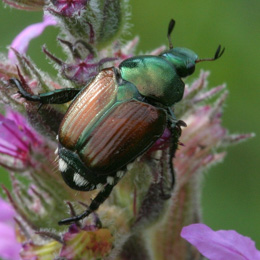 Figure 1. Popillia japonica adult
Figure 1. Popillia japonica adult
Photo courtesy David Cappaert, Bugwood.org
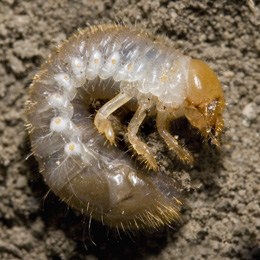 Figure 2. Popillia japonica larva (grub)
Figure 2. Popillia japonica larva (grub)
Photo courtesy David Cappaert, Bugwood.org
Life cycle
Popillia japonica has one generation per year. Based on trap catches in Vancouver, beetles begin to emerge from the soil and fly into traps in late June to early July, with populations peaking in early August. Beetles feed on fruit and foliage of many species of plants, and begin flying when the air temperature is about 21°C. Most flights are short distances, but the beetle is capable of flying up to 8 km with the aid of the wind.
Over her life span of several weeks, a female beetle deposits up to 60 eggs in soil of moist lawns and other grassy areas, within 2-5 cm of the soil surface. Eggs hatch in about two weeks and the small larvae begin to feed on grass roots through the summer and fall. Moisture is important for egg development and larval survival. Larvae spend the winter from 5 to 31 cm below the surface and resume feeding in the spring. There are three larval stages or instars. The insect passes the winter in the 3rd instar. Once larvae are full grown, they pupate in the soil in May or June for about two weeks before they emerge as adult beetles.
Hosts and feeding damage
Popillia japonica adults feed on the foliage and fruit of over 300 species of plants, including small fruits and berries, tree fruits, vegetables, field crops, woody and herbaceous ornamentals and shade trees. Preferred hosts include many plants in the rose family such as peach, apple, apricot, cherry, plum, and rose, as well as maple, elm, hollyhock, London plane, grapes, corn, asparagus and blueberries. As such, establishment of P. japonica in B.C. has the potential to seriously impact agricultural crops, as well as cause damage to urban gardens and landscapes.
Beetles prefer to feed on plants exposed to direct sunlight, beginning at the top and working downward. They feed on the upper surface of foliage, chewing the tissue between the veins, leaving a lace-like skeleton (see Figure 3).
Popillia japonica larvae feed primarily on the roots of turf grass but will also feed on roots of other plants. Injured turf develops dead brown patches in late summer to fall. Affected turf can be easily lifted and pulled back to reveal the grubs beneath. Additional damage may be caused by birds or animals such as skunks and raccoons digging for grubs (Figure 4). This is similar damage caused by European chafer larvae, which is well established in metro Vancouver.
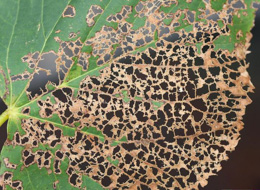 Figure 3. Popillia japonica feeding damage. Photo courtesy Steven Katovich, USDA Forest Service, Bugwood.org
Figure 3. Popillia japonica feeding damage. Photo courtesy Steven Katovich, USDA Forest Service, Bugwood.org
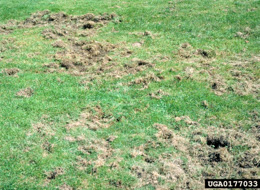 Figure 4. Damage to turf caused by Popillia japonica larvae (grubs) feeding on roots, and vertebrate damage from digging up turf. Photo courtesy M.G. Klein, USDA Agricultural Research Service, Bugwood.org
Figure 4. Damage to turf caused by Popillia japonica larvae (grubs) feeding on roots, and vertebrate damage from digging up turf. Photo courtesy M.G. Klein, USDA Agricultural Research Service, Bugwood.org
Eradication program
The Ministry is leading a coordinated effort to eradicate P. japonica from Metro Vancouver, in cooperation with the Canadian Food Inspection Agency, the cities of Vancouver, Burnaby, Port Coquitlam, and Richmond, industry and non-government organizations. This cooperative program has several components, including:
- Surveillance - CFIA conducts an intensive trapping program for P. japonica in and around infested areas. This is important to determine where the pest is present, and to monitor its spread, and determine if treatments are effective.
- Movement Controls - CFIA has established regulated areas based on where the beetle is known to be present. In these areas, there are movement restrictions on outdoor plants with roots and soil attached to help prevent spread of the P. japonica out of the infested area.
- Treatments – Once per year treatments are applied with ground equipment by trained and licensed applicators and are as unobtrusive as possible.
- A larvicide (Acelepryn, chlorantraniliprole) is applied once per year between April and September to turf in the infested areas to kill Popillia japonica larvae.
- The larvicide specifically targets beetle larvae and does not pose a risk to people, pets, birds, other insects, or animals.
Surveillance
CFIA conducts an intensive surveillance program using traps for P. japonica beetles in and around infested areas, in addition to traps at a lower density placed across Southern B.C. Trapping is important to determine where and when the insect is present, and to monitor its spread over time. There are a few different shapes of traps, one example is shown in Figure 5. All traps contain a P. japonica beetle attractant, which is a combination of a floral lure and a pheromone. The traps and lures do not pose a risk to humans, pets, birds and other animals or other insects.
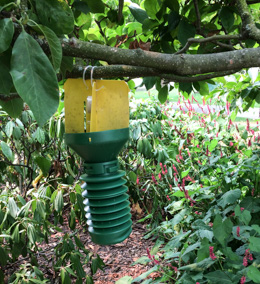 Figure 5. Popillia japonica trap
Figure 5. Popillia japonica trap
Movement controls
As part of the coordinated response to the detection of Japanese beetle, the CFIA has established regulated areas for P. japonica in Vancouver, Burnaby, and Port Coquitlam. The regulated areas have been expanded in May 2023 because of where beetles were caught in 2021 and 2022.
See interactive map for regulated area here: https://inspection.canada.ca/plant-health/invasive-species/insects/japanese-beetle/regulated-areas/eng/1656012404559/1656012405146
In May 2023, because of the low number of beetles caught in 2022 and 2021, CFIA removed some of the regulated articles. Soil alone and green waste are no longer regulated. However, the movement of plants with roots and soil or media attached is still regulated. These cannot be moved out of the regulated areas in Vancouver, Burnaby, and Port Coquitlam without a permit from CFIA. These regulations remain in place in 2024.
The movement of rooted plants with soil attached out of the regulated areas is restricted all year round.
For more information about the regulated areas and details on how to obtain a movement certificate, refer to the CFIA document here: https://inspection.canada.ca/plant-health/invasive-species/insects/japanese-beetle/japanese-beetle-in-british-columbia/eng/1525800137593/1525800137983
Or contact the local CFIA office.
Exemptions: Many things will be exempt from movement restrictions. These include things that are unlikely to be a pathway for the movement of P. japonica larvae, pupae or adults, such as:
- Plants and plant parts, including plant root systems (e.g. roots, rhizomes, tubers, corms, bulbs) that are substantially free from soil. This means the roots have been cleaned off by shaking, washing, or brushing, and there are no clumps of soil or media larger than 1 cm wide.
- Houseplants (non-commercial) which have been grown indoors and have not been set outdoors as patio plants
- Fresh fruits and vegetables for consumption
Treatments
The coordinated response for 2024 includes a single larvicide treatment of turf grass on public and private lands within the treatment zones in the cities.
The Ministry is coordinating treatment plans with the City of Vancouver, Burnaby, Port Coquitlam, Richmond, CFIA, landscapers, and other partners based on the identified priority areas.
The cities will coordinate the treatment of public lands with turf grass and landscapes at risk where P. japonica has been detected. Treatment of private lands will be coordinated by the cities, licensed applicators, and the Ministry.
The larvicide used to treat for this pest, Acelepyrn (chlorantraniliprole), is a reduced risk product approved by Health Canada. The product is applied by ground application once a year, and the P. japonica larvae contact or ingest the chemical while they are feeding on turf and plant roots. Acelepryn was selected for the treatment due to its very low toxicity and favourable environmental profile. The larvicide controls root-eating grubs, and will not impact people, pets, mammals, birds, bees, butterflies or other plants and animals, including any mammals or birds that eat the treated grubs. The treatment will be applied manually by trained and licensed applicators and will be as unobtrusive as possible.
What you can do to help
Report sightings of P. japonica in British Columbia to the Canadian Food Inspection Agency.
Do not remove, relocate or interfere with P. japonica traps.
Do not transport soil or plant parts out of the regulated area (as described under movement controls) without permission from the CFIA. You can also assist the CFIA by reporting all illegal movement of regulated materials.
Report sightings of P. japonica in B.C. to the Canadian Food Inspection Agency:
Call 1-800-442-2342 or visit www.inspection.gc.ca/jb
Resources
More information
AgriService BC
Have a question? Call or email us.
Telephone: 1 888 221-7141
E-mail: AgriServiceBC@gov.bc.ca
